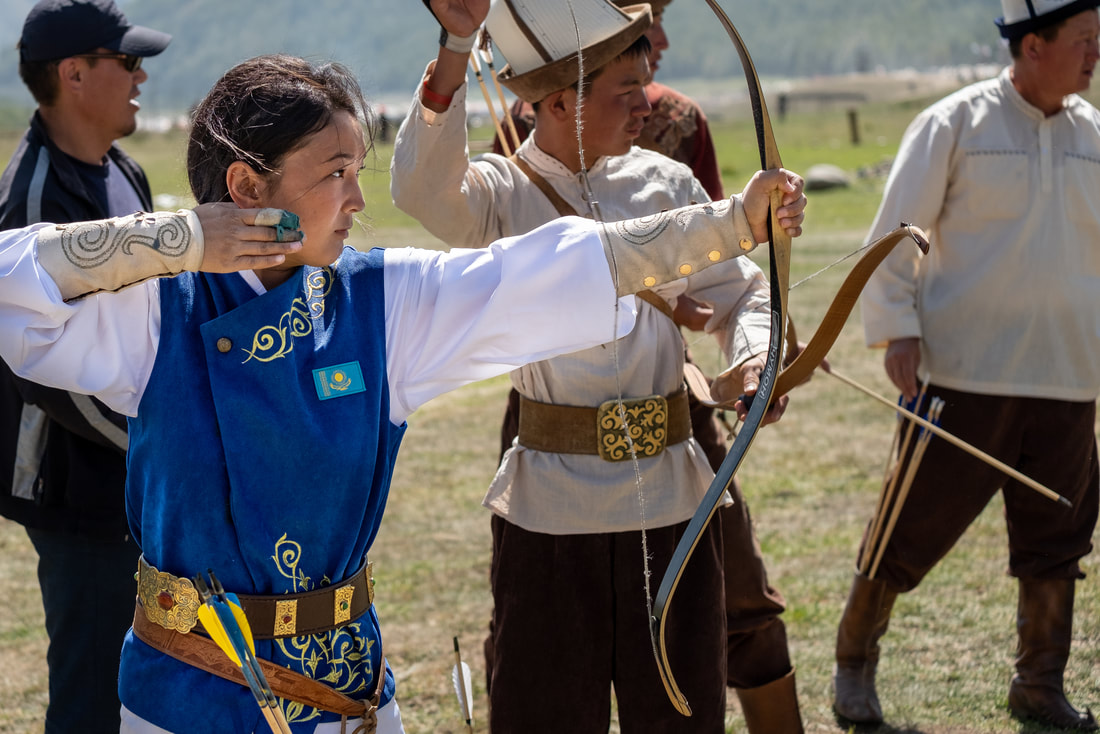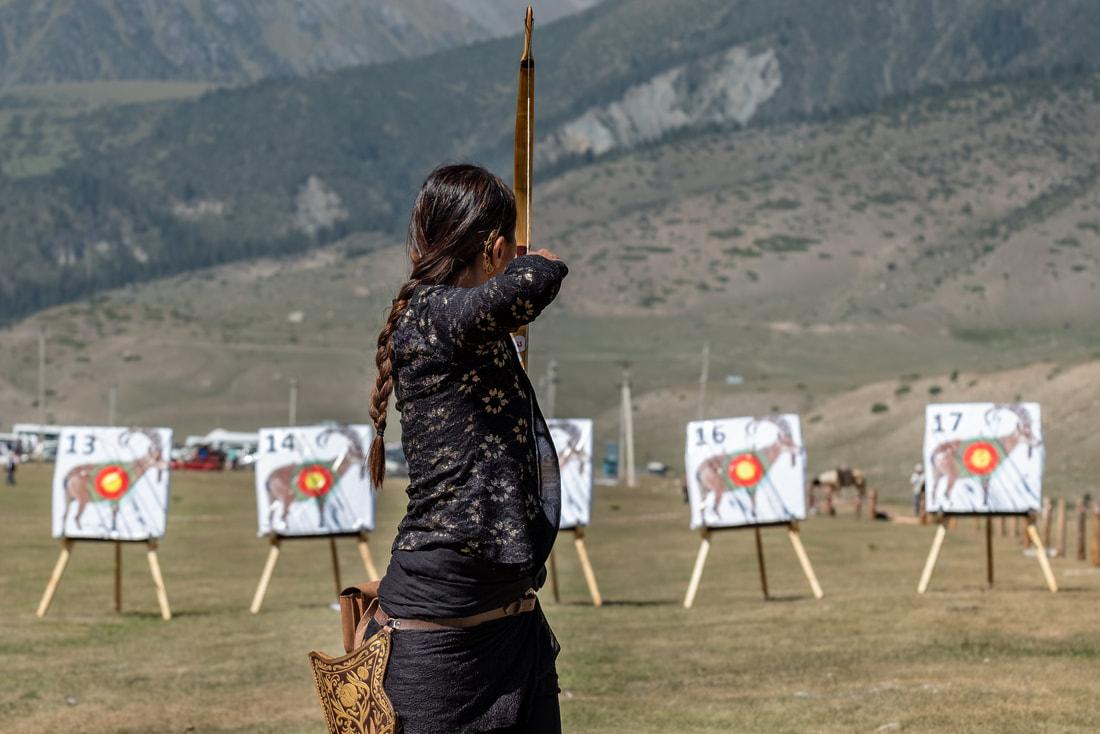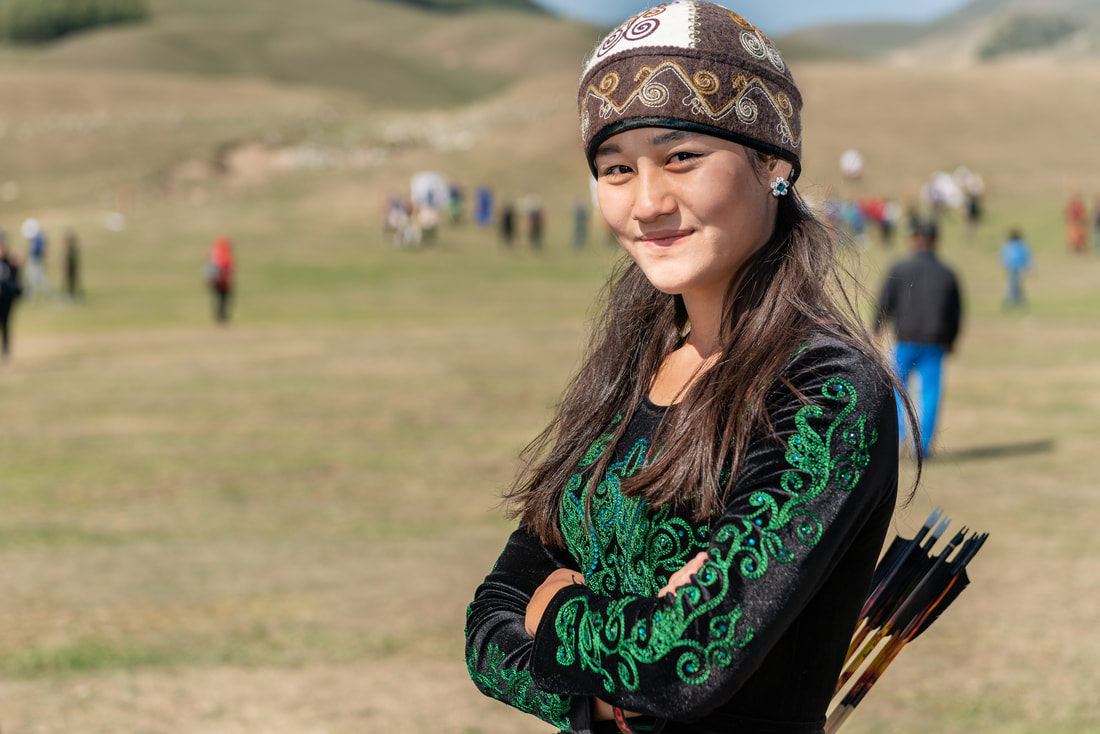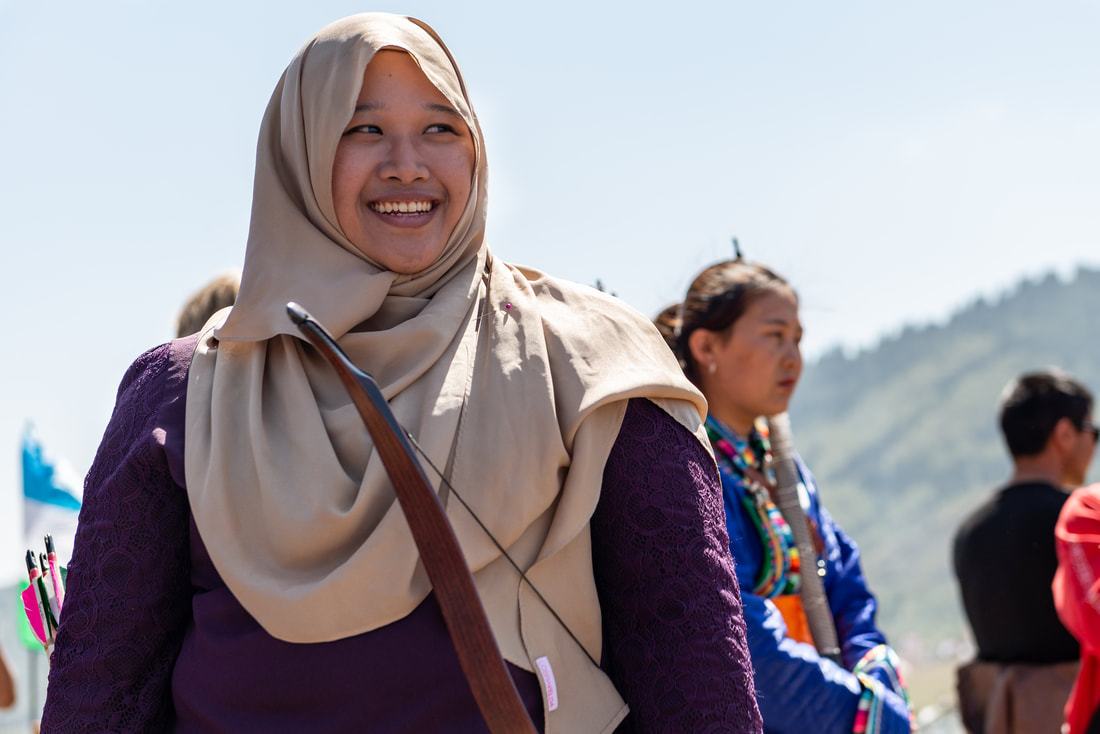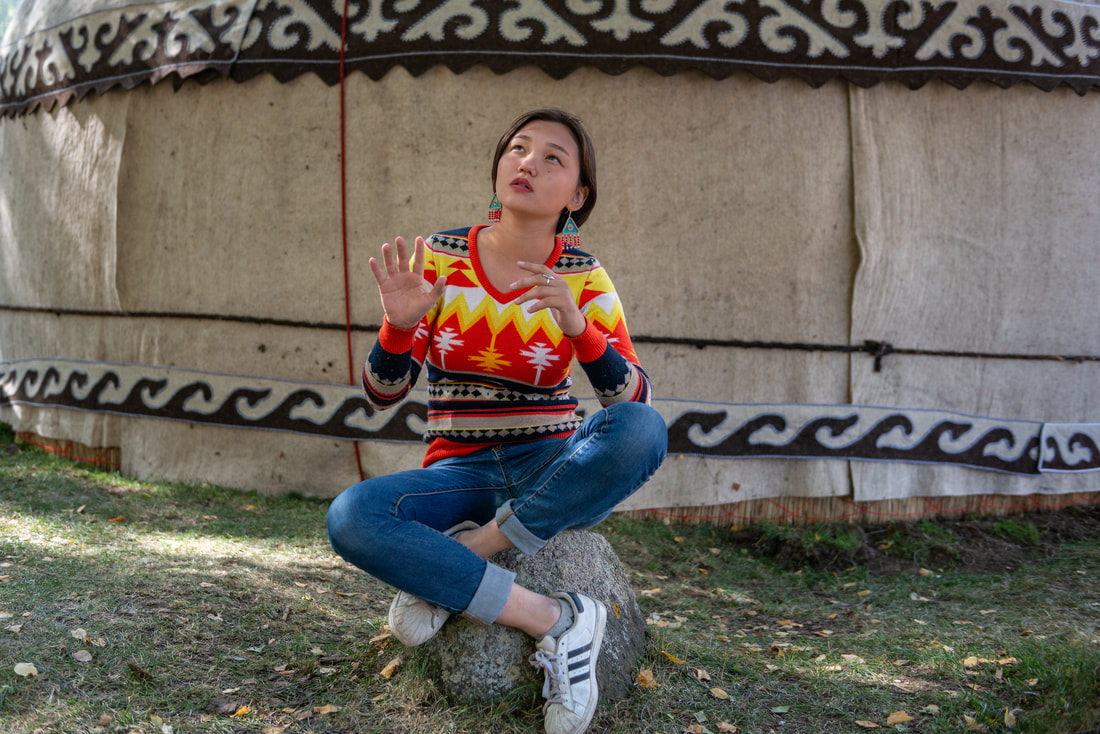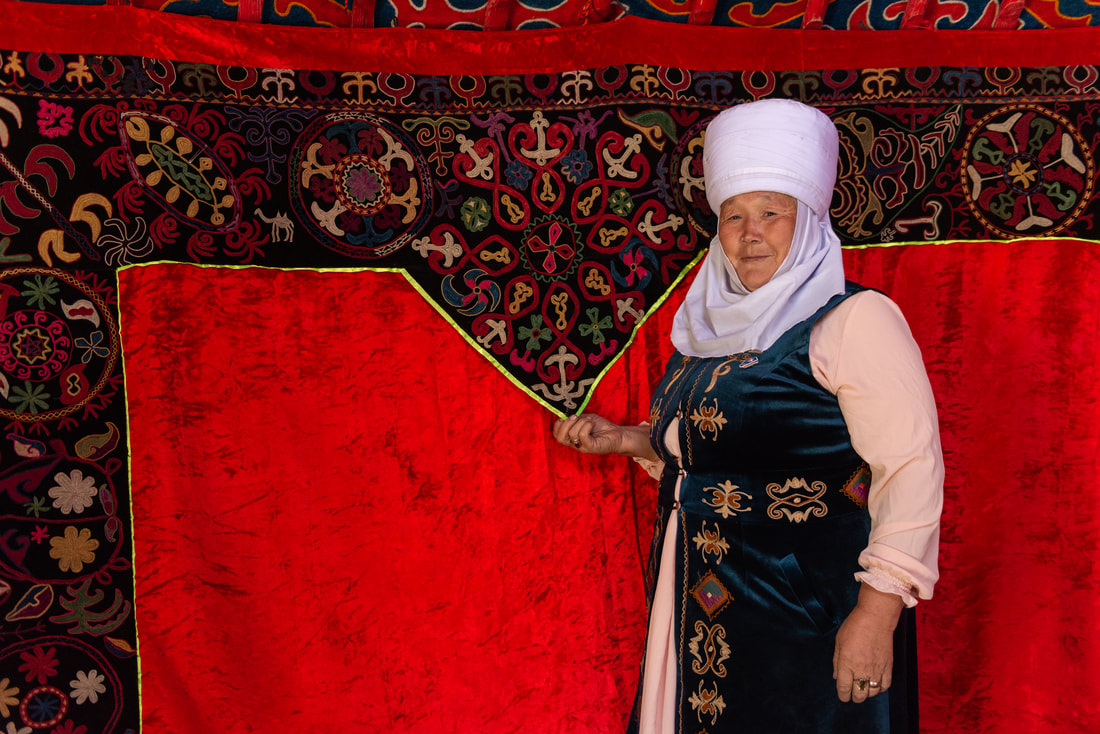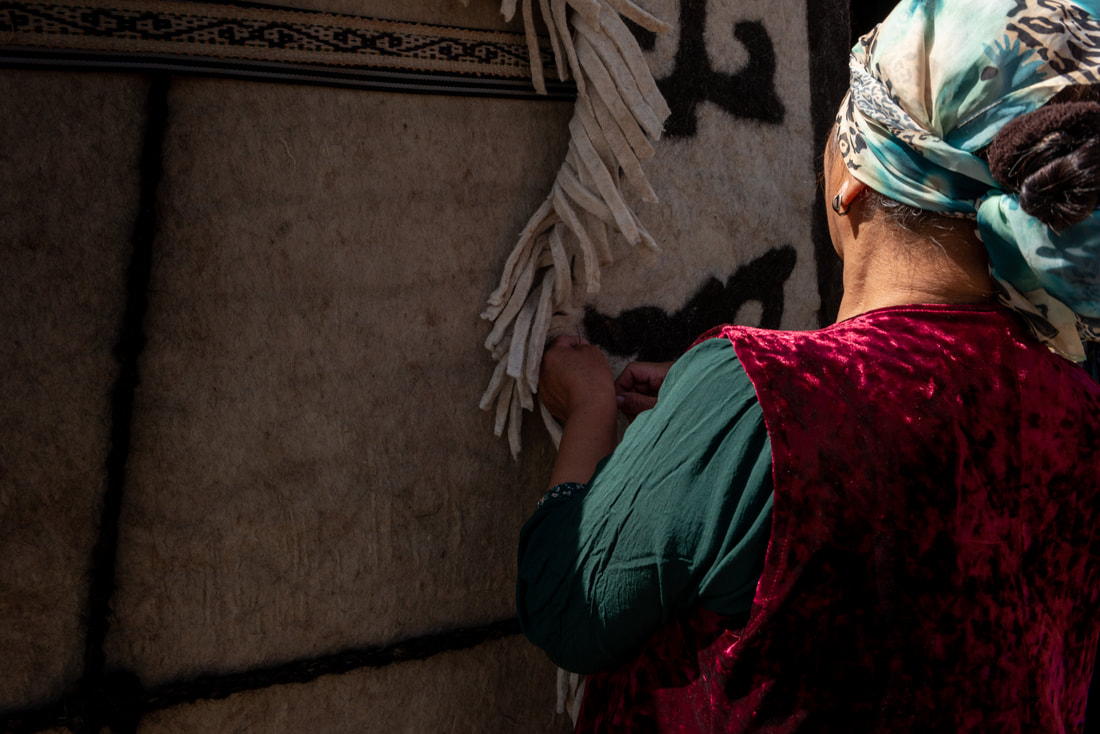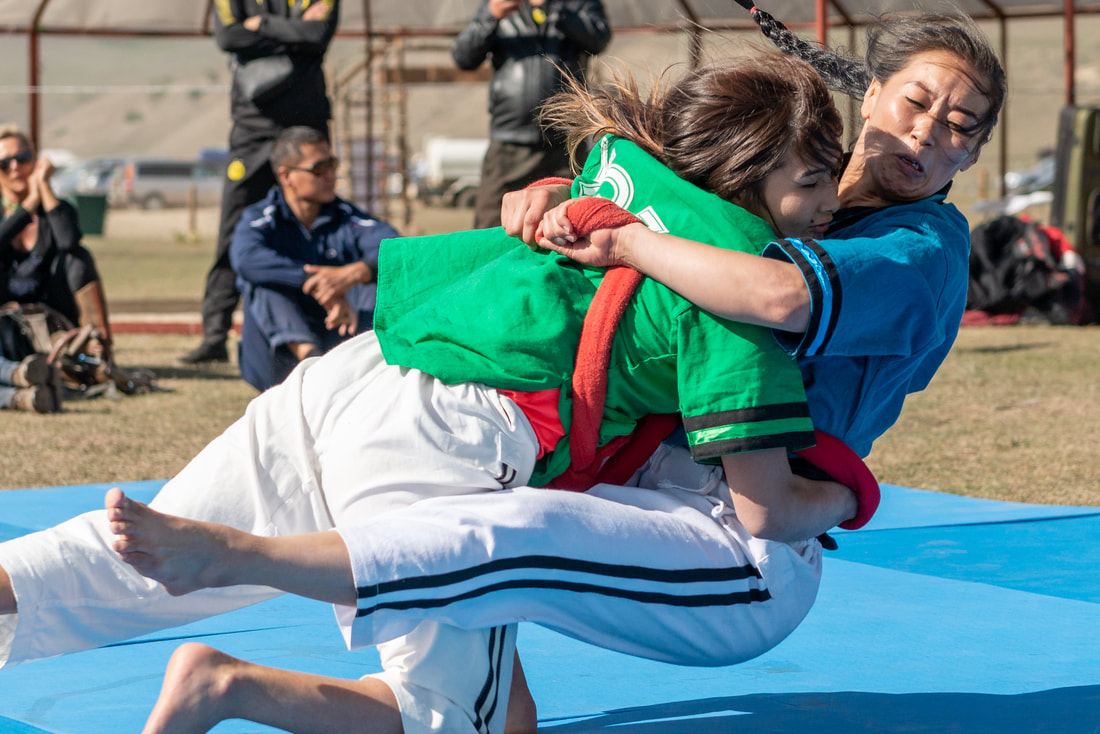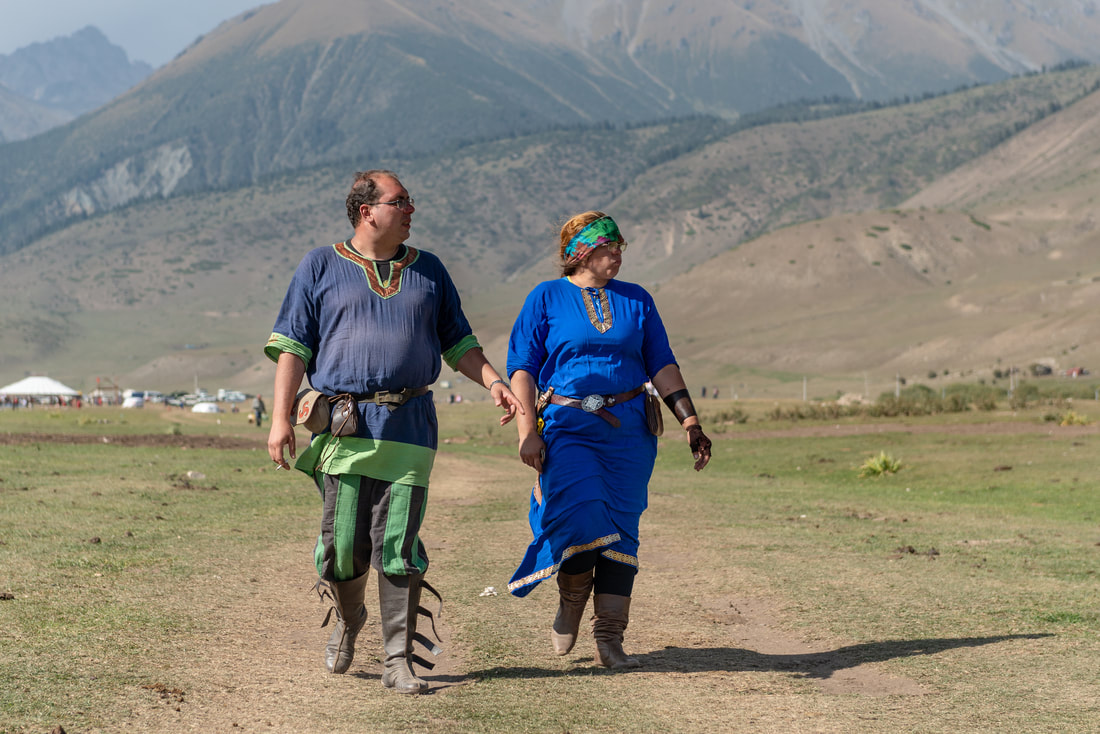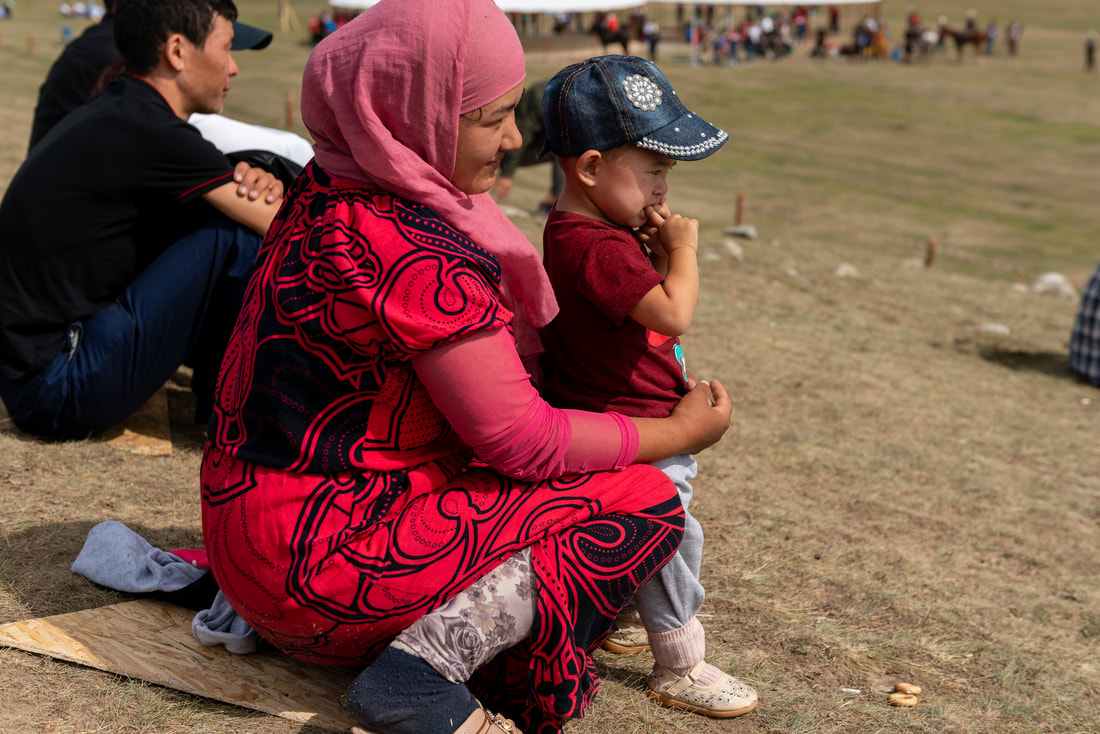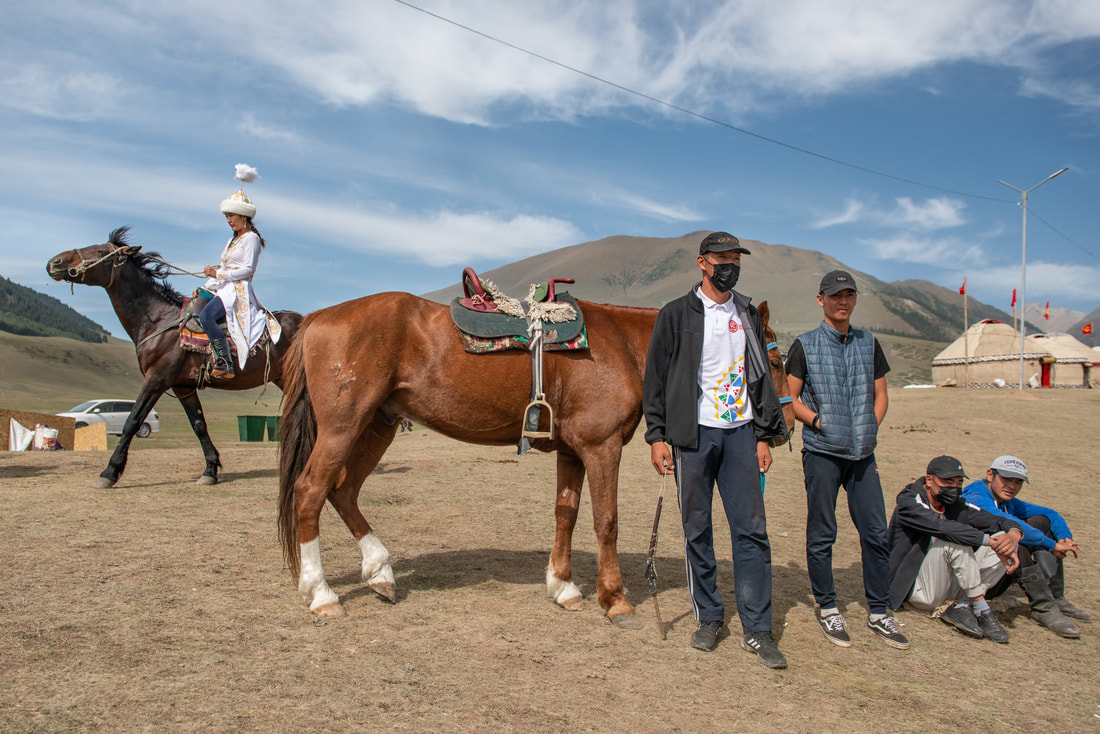Women of the World Nomad Games
By
Eleanor Moseman
Since 2014, Kyrgyzstan has hosted the World Nomad Games that attracts thousands of people to compete in traditional nomadic sports and customs. The week-long event is aimed to preserve culture and customs while sharing the traditions of ancient tribes with the world. The third World Nomad Games took place from September 2nd through the 8th, 2018 in the Issyk-Kul province of Kyrgyzstan. Under UNESCO patronage, this sporting and cultural event is the biggest international project held in the Kyrgyz Republic and initiates the preservation and revival of nomadic culture. The slogan for 2018 “United in Strength! United in Spirit!” encourages the mission of fostering a more tolerant and open relationship among the diverse tribes of the world. Not just competitors and people of Central Asia but including Europe and North America. The first-ever World Nomad Games came to Kyrgyzstan in 2014 with 600 athletes from 19 countries. This year, 3,000 athletes from 77 countries around the world competed in 37 medieval and nomadic sports along with a week-long ethnocultural festival, “Nomad Universe”.
Unique events at the World Nomad Games include: “Undok”, “Chyrga, “Alysh”, “Toguz-Korgool”.
“Undok” and “Chyrga” are eagle-hunting (“Burkut Saluu”) competitions. “Undok”, the bird of prey sits at a distance of 200 meters and flies to the hunter with bait in hand. The bird with the fastest flight will be deemed the winner. In the sport of “Chyrga”, a plaster cast from fox skins will be dragged behind a horse and the eagle must fly with skill and precision to the bait.
“Alysh” is traditional belt wrestling and one of the most ancient games of Kyrgyzstan. With the minimal movement of wrestlers, the goal is to pin the opponent down by their belt.
“Toguz-Korgool” is an intellectual game between two players and was originally meant to develop a military strategy for warriors during peacetime.
“Undok” and “Chyrga” are eagle-hunting (“Burkut Saluu”) competitions. “Undok”, the bird of prey sits at a distance of 200 meters and flies to the hunter with bait in hand. The bird with the fastest flight will be deemed the winner. In the sport of “Chyrga”, a plaster cast from fox skins will be dragged behind a horse and the eagle must fly with skill and precision to the bait.
“Alysh” is traditional belt wrestling and one of the most ancient games of Kyrgyzstan. With the minimal movement of wrestlers, the goal is to pin the opponent down by their belt.
“Toguz-Korgool” is an intellectual game between two players and was originally meant to develop a military strategy for warriors during peacetime.
As an experienced adventuress among the far-flung lands of Central Asia and the Himalayas, I know that women practice sport and often excel at “masculine” skills. This idea often goes against the stereotypes and broad sweeping assumptions created and amplified through media among the West. This photo story was taken on to destroy stereotypes, honor countless women that have spent a lifetime excelling at sports of a bygone era, and hear what the spectators had to say about the excellence on display by women. Which, by unanimous accounts, all men and women were equally encouraging and supportive of all the women. Some even wishing their young daughters would go on to pursue a passion in competitive horseback riding and archery.
Saadat Beisheeeva rides with a referee during the opening ceremony for the archery competitions at the World Nomad Games
Lanset Genel speaks with her coach before competing in the finals for women’s mounted archery. The youngest female athlete for mounted archery, this 18-year-old from Turkey would go on to first for the women’s event.
Nathalie Suareze (Center) and Boncser Szilvia (right), both competing for Hungary, await their turns for the final round.
Nathalie Suareze (Center) and Boncser Szilvia (right), both competing for Hungary, await their turns for the final round.
Aliya Kamalova, from Kazakhstan, takes target practice with young men before the final of horse-mounted archery. At 21 years old, she’s been practicing the sport for two years, where the first year was just learning how to ride a horse. In the beginning, people told her it's not a sport for women but she pursues the sport because she feels that is a part of the Kazakh blood.
Serena Caballero receives support from her teammate, Susannah Winifield, before competing in the final rounds of mounted archery where she would place third at the World Nomad Games. Despite the competitive nature of these sports, the women are very supportive of one another and many states the best thing about competing is meeting people from all over the world, learning about the other cultures and new friends.
Ellana is coached by her father, Kostumov Farhat, on how to hold the reins to control her horse. She is 8 years old and both parents compete in the sport of archery. They say it’s a great way for the family to be together and support one another. Ellana tells all her classmates and friends about her love for the sport and horses, which has inspired other young girls to become interested.
Eliza Tynalieva takes some quiet moments to herself before competing in the women’s archery event. By comparison to other sports she has played, archery requires much more attention and concentration.
Eliza Tynalieva from Kyrgyzstan, places second in the women’s traditional archery, Hungarian style. Eliza has only been pursuing archery for two years and qualifies this spring for the World Nomad Games with no experience in the traditional style.
Eliza has always been inspired by her grandfather, a veteran of WWII, who used to perform tricks on horseback and acrobats on bars. Her parents had always been supportive of her sports activities which included basketball and soccer. She has two children and a very supportive husband, which makes the pursuit of her passion and sport easier.
Eliza has always been inspired by her grandfather, a veteran of WWII, who used to perform tricks on horseback and acrobats on bars. Her parents had always been supportive of her sports activities which included basketball and soccer. She has two children and a very supportive husband, which makes the pursuit of her passion and sport easier.
Katerina Chernova, from Russia, pulls an arrow as she stands on line to compete in the traditional archery competition, where she would place second for the Turkish style. Katerina has been practicing archery for three years and this is her first international completion.
Katerina feels that archery gives her skills that can’t be easily achieved in normal day activities, such as concentration and controlling emotions. Although the archery competitions are divided among the men and women at the World Nomad Games, she doesn’t feel that there is any difference between men and women as “We all have hands and eyes”.
Katerina feels that archery gives her skills that can’t be easily achieved in normal day activities, such as concentration and controlling emotions. Although the archery competitions are divided among the men and women at the World Nomad Games, she doesn’t feel that there is any difference between men and women as “We all have hands and eyes”.
Darima Cyrendodopova, from Buryatia of the Russian Federation, believes traditional archery is a way of expressing the spirit of her nation and the heritage of her ancestors. It’s part of her blood and she states that by continuing these traditional games, other people can learn and ultimately save their nomadic traditions.
Saadat Beisheeeva, from Kyrgyzstan, began practicing traditional archery as a hobby. She believes that women do face some difficulties that men don’t in this sport, one being the lack of support from the government to travel for competitions.
Nazima Salleh from Singapore lines up for the final shot of traditional archery and would be placed third for the South Koran style. She’s been competing for about three years and feels sport has helped her learn to relax and learn to focus. These aspects in training carry over into her daily life and allow her to be better in her career and family life.
Rustam kyzy Ayana, from Kyrgyzstan, is the youngest female archer to be competing at the World Nomad Games. At the age of 16, this is her first competition, and was drawn into the sport by simple curiosity. She says a challenge she faces as a woman, is that different thoughts come to her head and she must learn to overcome those to win. After high school, she plans to pursue study law, as she wants to “defend others and fight for justice”.
Saleha Rashidi from Singapore is competing for the first time internationally at the World Nomad Games. She thinks this sport allows you to be equally competitive with her male counterpart and doesn’t think it a bad idea to compete against them. Saleha states that her practice with archery has also given her strength and focus within her spirituality. The emphasis on discipline, inner strength, consciousness, unity, and harmony with nature are all aspects that resonate with her and the archery community.
Baktygul Rakymbaeva is one of the few women that recite the Epic of Manas. It’s a poem dating back to the 18th century and consists of approximately 500,000 lines. She’s 16 – years old, and began learning at the age of 4 but stopped because of others telling her that it was inappropriate for women to be reciting Manas. She started again when she was 12 and began to win competitions which brought support from her family and friends.
Anarkul Kamchybekova stands in front of embroidery that has been handed down through more than three generations. Anarkul wears her “ak elechek”, a traditional Kyrgyz hat for women that can consist of up to 60 meters in wrapped cloth. Anarkul and other women from the Naryn region, called “Nuska Ak Elechek Apalar Toshobu” were placed first for the performance of clothing, dance, and song.
A woman places some final pins through the wool of a yurt in Kyrchen during the World Nomad Games. There are competitions here for speed building of yurts but still one of many activities that do not include women.
Aizhanat Okasheva, from the Altai region of Russia, competes in a game of Toguz Kumalak with Jansaya Toilybai. Beginning as a chess player, she started playing Togus Kumalak just a few years ago while teaching German. An intellectual game, rather than a physical sport, you’ll see nearly as many women competing as men.
Meerin Momunova (blue) wrestles with her fellow Kyrgyz teammate, Ananra Ryskulova, during the performance of a traditional style of wrestling, called Alysh. Meerim is now a champion in Asia and has been competing since 2015, after a background in Judo.
According to Meerim, she states one of the advantages of Alysh, is the ease of the uniform for women. “Even Muslim Women that cover their faces can compete in this sport”. Meerim holds a degree in sports coaching and hopes to see more women come into this sport.
According to Meerim, she states one of the advantages of Alysh, is the ease of the uniform for women. “Even Muslim Women that cover their faces can compete in this sport”. Meerim holds a degree in sports coaching and hopes to see more women come into this sport.
Katerina Fedotova, from Ukraine, takes a walk with her husband after the first rounds of archery. She sees herself as lucky to be in a relationship with someone of similar interests and supportive of one another.
Katerina couldn’t understand why the woman and men were divided for the competitions and the targets moved closer, by approximately 10 meters, for the women archers, She, along with the other women, is as good as the men and have a chance at winning. One thing she feels is a greater obstacle for women than men, is the power over emotions.
Katerina couldn’t understand why the woman and men were divided for the competitions and the targets moved closer, by approximately 10 meters, for the women archers, She, along with the other women, is as good as the men and have a chance at winning. One thing she feels is a greater obstacle for women than men, is the power over emotions.
Jumabaeva Saliha sits with her son and husband, watching the final rounds of the women’s mounted archery competition. Her husband, Dilmurat Jumabaev, thinks it’s great to see women on horseback competing and feels women are as strong as men. Should their next child b a girl, he would love to see her rise horses and compete around the world.
Aidar Temerkanov (Center left) watches the women archers compete on horseback with his friends. He is impressed by how well the women are competing and believe they play on the same level as men.
Aidar feels the athletes should not be judged by their genders but by their merit. He stresses that women are supported to pursue their dream by men in Kyrgyzstan, as “there is equality between us” and to “be truly Muslim, you must respect women”.
Aidar feels the athletes should not be judged by their genders but by their merit. He stresses that women are supported to pursue their dream by men in Kyrgyzstan, as “there is equality between us” and to “be truly Muslim, you must respect women”.
A group of Kyrgyz female horseback performers take some time out from the games to ride together and talk. Their performance consisted of men chasing them for a kiss as if the men were “bride kidnapping”. But the tradition is mocked when the women return the chase, catching up to the kiss thief and whip him.
|
09/10/2021
|
Explore I Share
|
Eleanor Moseman | Visual Storyteller
|
Based in China for nearly 13 years until recently, She is a photographer that focuses on social and cultural narratives involving women and ethnic minorities of Tibet and Xinjiang. Striving to create imagery and stories that seek resolutions of the inflicted while sharing voices of the unknown and persecuted. She has been using her photography work and storytelling skills to contribute to anthropologists, historians, conservationists, and activists. Her work is often used to supplement published work in regards to the cultural genocide taking place in the Xinjiang Uyghur Autonomous Region and Tibet, and the environmental changes occurring on the Tibetan Plateau.
Accomplishments include being a TEDxShanghaiWomen presenter in 2016, recipient of the 2019 Ohio Arts Council Individual Excellence Award, one of the 14th Annual Julia Margaret Cameron Awards, and a 26,000-mile solo bicycle tour around China and Central Asia that spanned from 2010 to 2012. Eleanor’s photography and adventures have been published in The Guardian, PBS NewsHour, The Atlantic, Nikon: Learn & Explore, The LA Times, and many other international publications. Her work was recently on display at the United States Holocaust Memorial Museum and the Rose-Hulman Institute and currently on display at the British Museum in London. Currently, in Dayton, she is focusing primarily on portraiture and lifestyle photography. She recently returned from East Tibet during the initial COVID-19 outbreak and is dedicating time to building a permanent home in Dayton, building “The Lone Huntress Photography Studio” at Front Street that will specialize in portraiture and lifestyle photography while also serving as a gallery to her decades worth of visual archives from Asia. Currently enrolled at the University of Indiana, she is continuing her Tibetan language studies and preparing for Wilderness Medicine courses for her return to the Tibetan plateau. |


